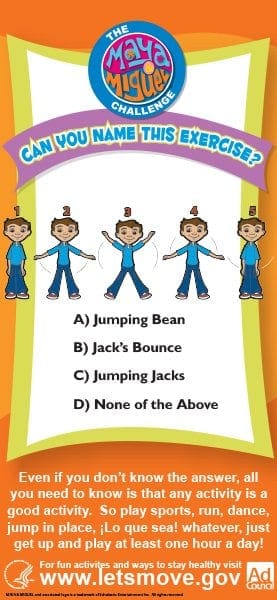Making Time for Fitness

Making Time for Fitness
Time management may be one of the most debilitating aspects of life for families with special needs children. I have heard the “we don’t have time” argument related to setting up a home-based fitness program a couple of times. In all honestly, it simply is not true. The biggest obstacle in the way of family fitness is motivation, the adaptive aspect of the PAC Profile. Adaptive abilities are not relegated to young people with special needs, but their parents as well. Where, in your own hierarchy of important life stuff, is physical health?
If given the question “Do you want the best possible transition into adulthood for your child?” the vast majority of parents would answer “Yes.” This is not groundbreaking, revolutionary information. I did not even cite a source or publication because it is a most proven and generally accepted thing that parents want their children to succeed. If the three aspects of general success are safety, health, and pursuit of interests (social, vocational, etc.), we need to examine the best strategies for each individual.
The mythology surrounding fitness in the U.S. includes the ideas that fitness and sports are the same thing, you have to play sports to be fit, thin people are automatically healthy people, a very active child does not need any further education in movement, and that children can naturally move well and continue to do so throughout life. These false premises are, quite literally, going to slowly kill a high percentage of today’s youth and possibly the generation after. At the time of this article, autism, Downs Syndrome, PDD, and other developmental disorders do not have clear preventability. Lifestyle related diseases including Type II Diabetes, some forms of Cancer, and cardiovascular disease can be prevented, and fitness is a mandatory part of that equation. Everybody should have exercise time most days of the week. Young people with special needs should have exercise time several times a day. A good body of well-conducted research and plenty of anecdotal and real world evidence demonstrate that young people, both neurotypical and those with special needs, perform better academically and socially when they move regularly. Our current educational system does not promote physical education as a principle aspect of development. The compartmentalization of each subject and the way it is taught has contributed to our current educational rank of 14th in the world according to the newest OECD data. It is also little help in establishing physical fitness as a life skill.
The solution to the fitness epidemic must be an approach that includes both public (school) and private (family and business) initiatives. For families with special needs children, the time has come to begin a reconsideration of lifestyle choices and how time at home is best spent. This does not mean that ten minutes after finishing this article you attempt to shove an hour of family fitness time in every day. For children, and for parents who have low levels of physical ability and motivation, this will likely be an overwhelming situation.
 I advocate beginning with 5-10 minutes of fitness time in the afternoon/evening and building up the amount over several weeks or months. The exercises? You can download the Top 8 Exercises for Autism Fitness for free on my website, www.AUTISMFITNESS.com and start with a few each day. Any of these exercises can be regressed (made simpler) or progressed (made more challenging) based on the ability of the individual. It is likely that everyone in the family will be at a different ability level with each exercise. By regressing and progressing the activity, it can be made as safe and effective as possible.
I advocate beginning with 5-10 minutes of fitness time in the afternoon/evening and building up the amount over several weeks or months. The exercises? You can download the Top 8 Exercises for Autism Fitness for free on my website, www.AUTISMFITNESS.com and start with a few each day. Any of these exercises can be regressed (made simpler) or progressed (made more challenging) based on the ability of the individual. It is likely that everyone in the family will be at a different ability level with each exercise. By regressing and progressing the activity, it can be made as safe and effective as possible.
With the introduction of the PAC Profile Assessment Toolbox, education programs finally have access to an all-encompassing special needs physical education curriculum. Redefining, re-educating, and re-energizing public and private special needs education programs will bring about some great changes and opportunities for students to become more physically able and healthy. On the family side, bringing fitness into the home can certainly provide much more benefit than a constant serving of TV and video games.
Introducing fitness into the special needs home does require patience, diligence, and an (eventual) enjoyment of physical activity. Along with increased physical health and abilities, parents can provide their children with skills that they will take into adulthood. There is no magical “mind/ body” connection; it is in fact all one unit. When we optimize our physical ability and the fitness of those around us, we increase cognitive and social functioning, and self-efficacy takes on new meaning.
More Fitness Fun
- It’s “Time” to get Fit!
- The Family Factor of Five: Making Time for Fitness (and Actually Doing It)
- Let’s Go Fitness Co-founded by father and son with (Prader-Willi)
- Life as We Grow It: Fitness as a Life Skill for Special Needs Populations
- The 7 Habits of Highly Successful Fitness Programs
- How Do You Get Your Kids Active?
- The Power of Play
- Waving Not Drowning: The Process of Making Fitness Fun
- Fitness Fun: Incorporating Fitness into the Classroom
- Looking for a Fun Family Exercise? How About Parkour!
- Fitness Equipment Worth Buying
- Do You Struggle With Planning Healthy Meals for Your Family?
This post originally appeared on our January/February 2011 Magazine



